2020 Kia Sonet diesel auto and manual road test review
As far as big cars go, there seems to be nothing bigger at the moment than the fairly diminutive Kia Sonet. At least that's what it feels like whenever we speak about it or are even seen in one. But that's not really surprising, is it? The Sonet promises all the qualities that Kia has very quickly become known for - great looks, thoughtful packaging and a nice drive - in a more compact and consequently at a more affordable price point.
The question is though, is the Sonet a worthy follow-up to the segment-busting Seltos and Carnival? And can it fully capitalize on the brand value that these two cars have generated so far, and turn it into truly mainstream success? Some time behind the wheel should answer that.
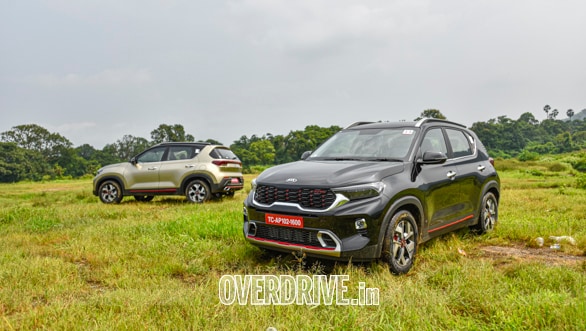
Kia Sonet Styling
The Sonet's look is a more extroverted take on Kia's design concept but developed keeping in mind what Indian customers expect. Another interpretation of the Tiger Nose grille continues to be front and centre. It's more deep-set and condensed in this form, and in conjunction with the compact headlamps creates a very athletic face. These traditionally-placed, crisp, segmented LED units are refreshing after the recent wave of split-headlamp SUVs. This sense becomes accentuated by details like the knurled chrome strip cradling the grille, the sculpted edges to the bonnet and the large air dam(which handles most of the airflow into the engine) with those silver-finished knuckles and the deep-set fog-lamp inserts. The red and gloss black highlights and red-highlighted 205/60 R16 dual-tone wheels on the GT Line seen here adds another layer to this sense of purpose.
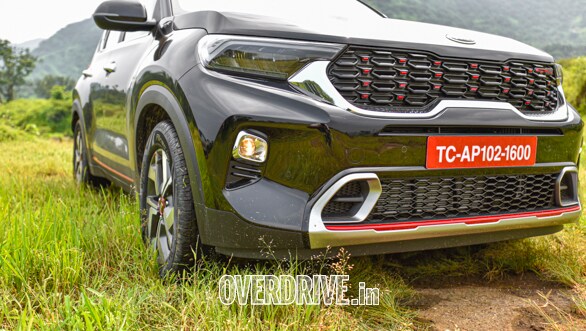
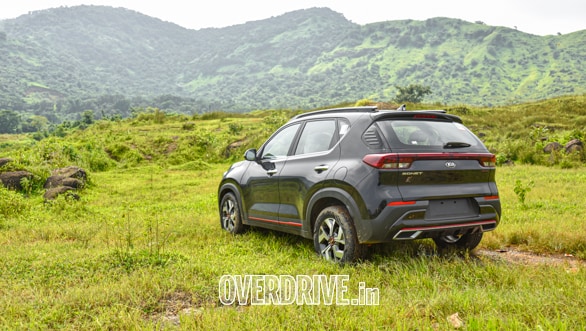
In profile, the Sonet makes good work of bringing the traditional long bonnet and squat rear-end look to an SUV, especially commendable given the length constraints in this segment. The unique treatment to the C-Pillar with the functional, ridged gloss-black inserts removes a lot of visual bulk from the top of the car, as do those prominent haunches over the rear wheels. Similarly at the rear, the distinctive full-width strip between the blocky LED taillamps and the concave treatment of the boot lid below that, cover what would otherwise have been masses of flat sheet metal. The ornamental exhaust tips and diffuser spruce this part of the Sonet up further. Sure, there have been other, boxier cars in this segment that have as much or more cohesion to their look, but the Sonet brings a sense of richness and complexity that is missing elsewhere.
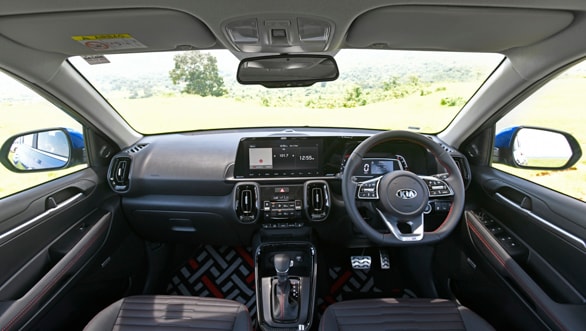
Kia Sonet Interiors and features
The interiors of the Sonet break away from convention as well. The segment-leading 10.25-inch touchscreen seen on top-spec cars catches your eye first. It's a straight lift from the Seltos and brings with it all of its functionality and ease of use. So you get navigation and an even more expanded list of connected car features. The UVO system can now remote start a manual car, same as what was seen on the Creta, although new are voice commands to operate windows, the air purifier and even the climate control modes, among other things.
The instrument cluster in front of the driver is a big departure from the one in the Seltos. The large LCD speedo and MID between the vertical dials are equally eye-catching and legible. But the layout feels slightly disjointed, especially against the straightforward dials in the Carnival and Seltos.

The vertically oriented dash design is another way in which Kia has mixed things up with the Sonet. The large vertical vents, which haven't given up on function with their form, and the curved dash faces make this a unique place to spend time in. If anything, the central bank of buttons that control the climate could have been better integrated. This layout, with the similar-looking buttons below for the drive modes and seat ventilation, can take some getting used to.
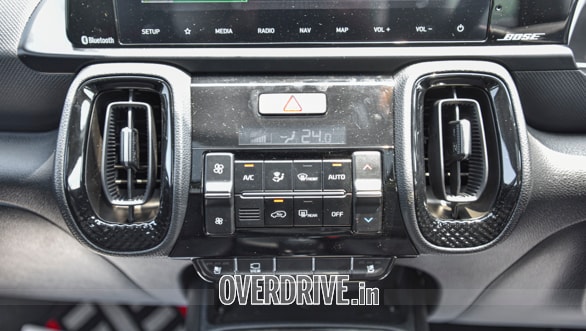

But we suspect buyers will overlook this very easily with the perception of quality that Kia has managed to bring to the Sonet's cabin. There aren't too many soft-touch surfaces around but the quality of materials used and their fit is segment-leading. We especially liked how every button has a substantial, damped action to them. Similarly, the textured gloss black detailing and silver accents are just enough to stop things from becoming dull. The all-black theme seen here and the contrasting red stitching on the ridged upholstery are exclusive to the GT Line and do their job of creating a sense of purpose in this space.
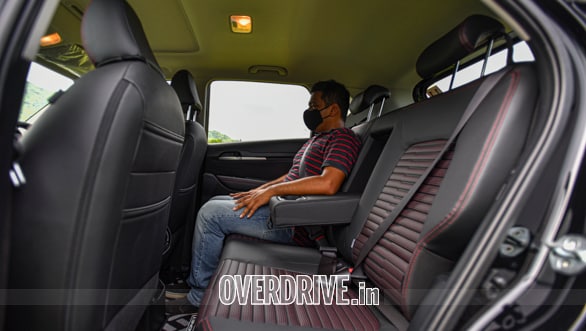
The Sonet shares its bones with the Venue, and some of that car's traits have carried over here as well. The rear seat isn't the nicest one in this segment, with the short bench lacking much under-thigh support, although the form of the front seats frees up a good chunk of legroom. It's also not wide enough to fit three adults in comfort over longer journeys. Having said that, even with the upward sweeping window-line and dark theme, there is enough natural light coming in here. Somehow the jazzy design of the floor mats also help with this. Also great are the many storage spaces on offer, integrating the wireless charger and air purifier into the design from the beginning has allowed Kia to maximize this even further.

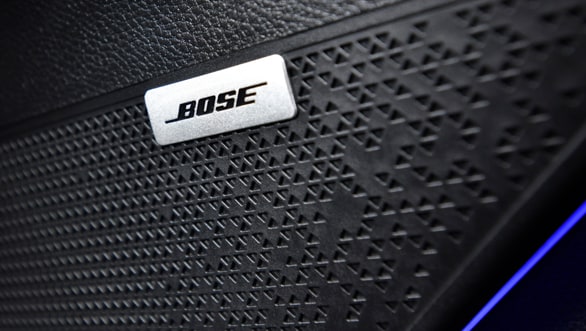
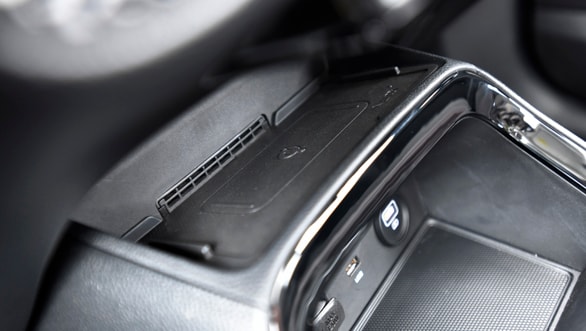
But in this segment buyers seem to like practicality and convenience in equal measure. Kia has played to the crowd in that sense, filling the Sonet to the brim with kit almost too long to list here. Segment-first highlights though, aside from the touchscreen, UVO and immensely useful ventilated seats already mentioned, are the virus combating air purifier, seven-speaker Bose audio, ambient lighting, remote engine start through the key, cooled wireless charging, multiple active Bluetooth connections and so on. Thankfully, these features actually add value to the driving experience with how they have been integrated into this package, and haven't just been put in to make the numbers. But to get most of them, we suggest you look at the mid to higher-spec Sonet variants.
Even the boot is a segment-leading 392 litres. It also helps that the opening to this is wide and square with quite a low lip. Thoughtfully, Kia has neatly integrated the sub-woofer into the trim, so you have more usable space inside.
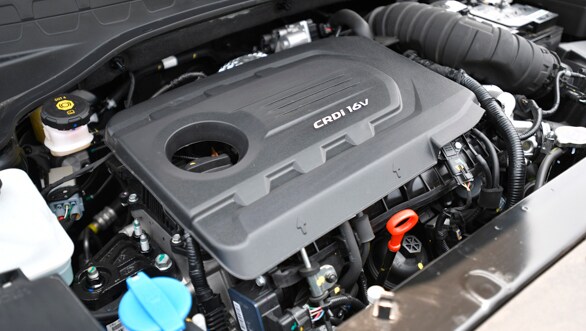
Kia Sonet Engines and efficiency
Get into the well-supported driver's seat of the Sonet, and the way the dash with its high edge envelopes you points to a car that wants you to have some fun with it. Conversely, if you like a large glass area around you with easy visibility, then this might not be to your liking. Anyway, the steering wheel is the very nice leather-trimmed one from the Seltos and is placed well enough for you to not miss the reach adjustment not available here, the seat height adjustment on offer makes finding an ideal driving position easier still.
Like the newest Hyundai-Kia products, the Sonet offers a bewildering range of engine and gearbox options. A 1.2-litre naturally aspirated petrol starts things off with 83PS and 115 Nm and pairs with a five-speed manual only. Kia, like Hyundai, remains deeply committed to diesels and is offering two different tunes of its 1.5-litre diesel motor here. The lesser one makes 100PS and 240 Nm with a six-speed manual. Only the 1.2-litre petrol is limited to the Tech Line, which also gets the turbo-petrol iMT and the diesel-manual. The GT Line can be had with all engine/gearbox options other than the naturally-aspirated petrol. The 1.0-litre turbo-petrol makes 120PS and 172 Nm and can be had with a six-speed iMT or a seven-speed DCT. The Seltos' enthusiast-baiting turbo-petrol/manual combination has morphed into a diesel-powered one here.
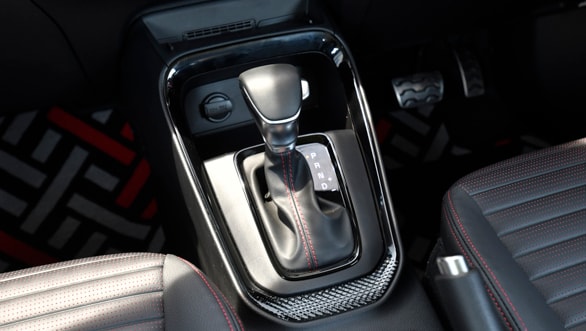
Our time in the Sonet was spent driving this diesel auto, the diesel manual in Tech Line guise and the turbo-petrol in both iMT and DCT flavour. You can read our review of the turbo-petrol Sonet here. With the six-speed torque-converter, the diesel's outputs are bumped up to 115PS and 250 Nm. That's the same as on the Seltos, but the effect here is altogether something else. The Sonet powered as such deeply impresses with the breadth of its ability on the move. It's near-silent at the daily grind and with the variable geometry turbo, the motor never feels out of its element in the low-speed on/off throttle applications here, even if the gearbox may sometimes take a touch more time than you like to choose the next cog. And then out on the highway, it's a calm mile-muncher, eating up distances effortlessly and in far greater eagerness than you would expect from anything of its type. It's also very efficient in such situations, given that it'll keep revs between the 1,500-2,000 rpm range in most regular driving situations. Our testing got us almost 12 kmpl in the city and over 19 kmpl on the highway. Many other cars in this price bracket will perform in much the same way in such conditions. The Sonet takes the game forward simply with the way it elevates this experience with its refinement.

Where the Sonet cements its place at the top of this class is in the instances where you push it beyond these situations. Kia has retuned this gearbox for better responsiveness, and that has uncorked a chunk more alertness from the engine. A well-intended tap of the pedal is all it takes for the transmission to shift down, and put you right in the powerband. With the motor handing you torque right past 4,000 rpm, you'll always have a chunk of performance at your disposal every time you need it. The drive modes alter the throttle response and shift points, but the normal mode is balanced enough for you to not need Eco or Sport too often. If we had to pick one fault, it'd be the absence of paddle shifters and the gearbox' tendency to not hold revs at the limit, even in manual mode. This seems to slightly water-down an otherwise engaging experience.
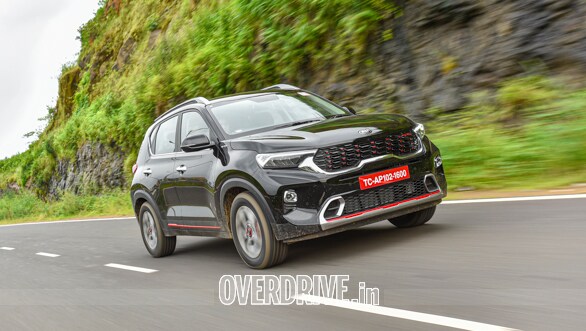
Kia Sonet Ride and Handling
Now a decisive engine wouldn't be much cop if it couldn't put all its performance down on the road. Thankfully, Kia hasn't let this happen with the Sonet. The steering in the Sonet feels consistently weighed and precise, without getting laborious in traffic. It's the same with the ride quality. Aside from some deep ruts taken quickly, where things get noisy, the Sonet absorbs most things you find on our road surfaces very well. There is none of the low-speed harshness over broken surfaces you might find elsewhere at this price point. This becomes even more composed the faster you go with very few bumps or jolts getting to the cabin.
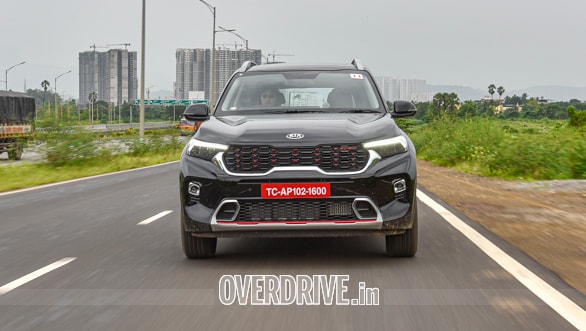
In fact, this and the impressive body control it has on offer makes the Sonet quite confident around bends too, in line with the youthfulness that the GT Line's looks promise. Of course, there is some lean but the SUV makes sure to keep following the line you want it to, even at speed. This also means that it handles high-speed undulations without unwarranted vertical or lateral movements. Effectively, a sense of progressiveness and predictability is apparent in how the SUV handles itself. The only aberration to this experience is that we would have liked more braking force. Even the GT Line does not get rear-disc brakes, with the performance and control on offer this feels like a big oversight.

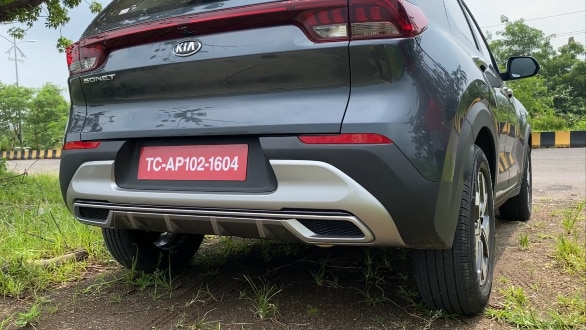
How is the Tech Line different from the GT Line?
Just as in the Seltos, the Tech Line may be more affordable than the GT Line cars, but this isn't exactly a lesser trim. In the Sonet, the Tech Line is aimed at the more pragmatic buyer. This shows in the more straightforward grille, and the simpler silver-finished front and rear scuff plates, which replace the more intricate gloss-black/red ones in the GT Line. Having said that, these bits add a fair dose of SUV-ness, as compared to the more slick GT cars.
On the inside, Tech Line Sonets come with a dual-tone black and off-white interior. This light shade creates a greater sense of space although it doesn't quite recreate the same richness of the GT Line's cabin, especially around the centre console area. But aside from a few cosmetic flourishes, you don't exactly lose out on any of the GT Line's features in the top-spec HTX+. However, there are five Tech Line variants to choose from against the single GTX+.
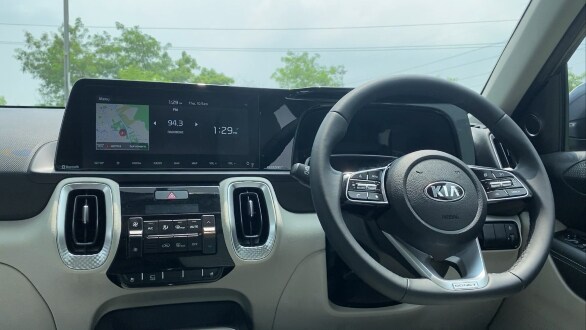

We drove the Tech Line in its diesel manual, one also seen on the GT Line. Like we said earlier, this version uses a detuned fixed geometry turbocharged version of the 1.5-litre diesel. Outputs are 100PS and 240 Nm, 15PS and 10 Nm down on the one in the automatic version. This deficit notwithstanding, this diesel is actually quicker to 100 kmph from standstill. Blame that on Hyundai/Kia auto boxes' tendency to limit revs in self-preservation during hard launches. In the real world though, this is again an engaging machine to spend time in. Especially if you are a traditionalist who likes a slick-shifting manual. Like most manual gearboxes from Hyundai and Kia, this one feels effortless to use with its well-defined short throw and light, progressive clutch.
As the only engine option available on all trims of the Sonet, Kia has tuned this version of the diesel to be a bit more subdued. The responses from it are a touch softer, though not a whole lot less effective than the automatic. Although, the absence of the quick-reacting VGT shows up in some noticeable delay when you find yourself below 1,500 rpm. But we think a short amount of time behind the wheel is all you will need to learn your way around that. Once past this, this engine is as competent as they come, offering a wide powerband, impressive refinement and reasonable fuel efficiency.
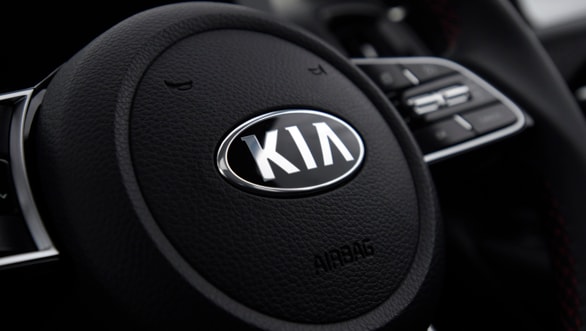
Kia Sonet Safety
Kia has followed the more is better adage here too. The top-spec cars get equipment like front parking sensors and TPMS, both segment firsts, alongside the dynamic guidelines for the camera. Even the Hyundai-staple always available rear-camera feed brings an added sense of security. There are up to six airbags on offer, par for the course in this segment. Kia also offers the Sonet with traction modes, which will alter ESP and ABS intervention in keeping with the surface you are on. Having said that, the Sonet remains a soft-roader at best with no AWD option on offer.
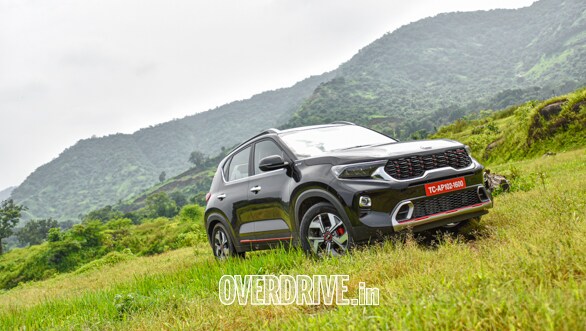
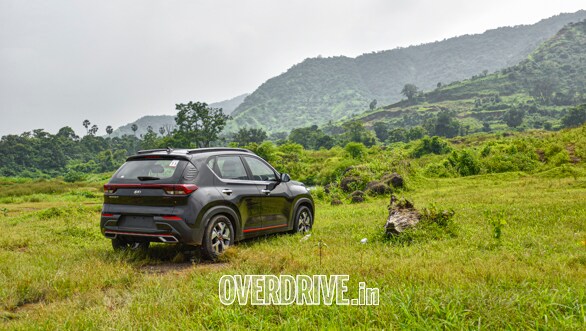
Kia Sonet Verdict
There is no doubt that Kia Motors India has another success on its hands. So far, as good as SUVs have been in this segment, that sense of being built to a price hasn't left any of them. The Sonet doesn't feel like that. Just like what it did with the Seltos, Kia has come into a new segment and redefined what buyers can expect here. It doesn't give anything away to rivals in most respects you would consider in your buying decision. And with the never-ending trim and engine/gearbox choices on offer, a Sonet that fits your needs exactly shouldn't be too hard to find. We don't know prices just yet, but Kia has matched pricing with its Korean cousin before, so major surprises are not expected.
This top-tier diesel automatic though will be expensive, a mid-spec version is also available. Having said that, the Sonet, especially in this guise feels less like a cut-price SUV impersonator and more like a plausible, compact alternative to its C-segment brethren. Look at it that way, and if you don't need the extra space of a Seltos or Creta, then this is one of the most compelling SUVs buys in the country right now. The on-paper-lesser diesel manual though might be the real money maker for Kia. As the engine most commonly available in the range, the carmaker wants to seemingly maximise sales of this version. And that makes perfect sense, it may not be as forthcoming as its more powerful brother but could be the sweet spot between affordability and engagement.
Read our review of the Kia Sonet turbo-petrol iMT and DCT here
| Diesel-automatic | Diesel-manual | Petrol-iMT | Petrol-DCT | Petrol-Manual | |
| SPECIFICATIONS | |||||
| Type | 4-cylinder VGT turbo-diesel | 4-cylinder turbo-diesel | 3-cylinder turbo-petrol | 3-cylinder turbo-petrol | 4-cylinder naturally aspirated |
| Valvetrain | 4 valves/cylinder | 4 valves/cylinder | 4 valves/cylinder, direct injection | 4 valves/cylinder, direct injection | 4 valves/cylinder |
| Displacement | 1,493cc | 1,493cc | 998cc | 998cc | 1,197cc |
| Max power | 115PS@4,000rpm | 100PS@4,000rpm | 120@6,000rpm | 120@6,000rpm | |
| Max torque | 250Nm@1,500-2,750rpm | 240Nm@1,500-2,750rpm | 172Nm@1,500-4,000rpm | 172Nm@1,500-4,000rpm | |
| Gearbox | 6-speed torque converter | 6-speed manual | 6-speed clutchless manual | 7-speed dual-clutch | 5-speed manual |
| Suspension (f/r) | McPherson Strut/Torsion Beam | ||||
| Brakes (f/r) | Disc/Drum | ||||
| Wheels & tyres | 215/60 R16 | 215/60 R16, 195/65 R15 | 215/60 R16 | 215/60 R16 | 215/60 R16, 195/65 R15 |
| LxWxH(mm) | 3,995x1,790x1,642 | ||||
| Wheelbase | 2,500mm | ||||
| Boot space | 392l | ||||
| PERFORMANCE* | |||||
| 0-100kmph | 11.6s | 11.2s | 11.2s | 12.0s | N/A |
| 30-50kmph | 2.1s | 4.2s | 3.3s | 3.0s | N/A |
| 50-70kmph | 2.9s | 5.2s | 4.1s | 4.0s | N/A |
| 60-80kmph | 3.1s | 6.2s | 4.9s | 4.3s | N/A |
| 100-0kmph | 3.5s, 51.7m | 3.6s/49.1m | 3.3s, 43.6m | 3.4s,47.2m | N/A |
| EFFICIENCY* | |||||
| City | 11.88 kmpl | 13.01 kmpl | N/A | 12.31 kmpl | N/A |
| Highway | 19.57 kmpl | 18.07 kmpl | N/A | 18.22 kmpl | N/A |
| Overall | 13.80 kmpl | 14.32 kmpl | N/A | 13.78 kmpl | N/A |
|
*OVERDRIVE test figures
|
|||||
Also read,
2020 Kia Sonet SUV revealed: Everything you need to know
Image gallery: 2020 Kia Sonet India unveil
2020 Kia Sonet SUV: Top 10 feature highlights
Kia Sonet powertrain details, including segment-first six-speed diesel automatic
Watch our video review of the Sonet below:
Starts Rs 6.71 Lakhs
1493cc
Automatic
83
250
-NA-













